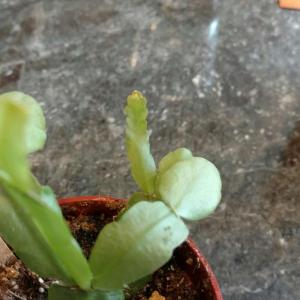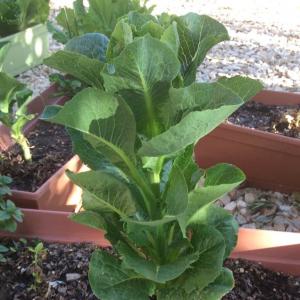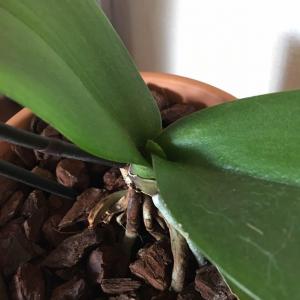文章
Dummer. ゛☀
2017年07月02日

Limonium Alias
Salt cloud grass, salt cloud ginseng, spoon leaf grass
Distribution of origin
The blood enriching grassland is produced in Russia, Bulgaria and Caucasus. It is mainly distributed on hillsides and meadow salt soils in Northeast
morphological characteristics
Herbs perennial, 15-60 cm tall, entire plant (except calyx) glabrous
Basal leaves, pale green or gray green, obovate oblong, oblong lanceolate to lanceolate, 4-12 cm long , 0.4-2.5 cm wide, apex usually obtuse or acute, tapering into petiole is flat, the majority, arranged in a rosette. Many rachides upper branches; flowers in the synthesis of short and dense spike, set was born in rachis branch top, spikelet stem leaves reduced to scales, brown, white membranous margin.
Blood growth habit
Limonium love cool climate, love light, after low temperature treatment at low temperature on flowering, 10-16 C in the seedling stage of flowering plants were treated with low temperature, high temperature will not affect the day after; if the seedlings without cold treatment, direct planting under high temperature, flowering was inhibited or will no flower.



Salt cloud grass, salt cloud ginseng, spoon leaf grass
Distribution of origin
The blood enriching grassland is produced in Russia, Bulgaria and Caucasus. It is mainly distributed on hillsides and meadow salt soils in Northeast
morphological characteristics
Herbs perennial, 15-60 cm tall, entire plant (except calyx) glabrous
Basal leaves, pale green or gray green, obovate oblong, oblong lanceolate to lanceolate, 4-12 cm long , 0.4-2.5 cm wide, apex usually obtuse or acute, tapering into petiole is flat, the majority, arranged in a rosette. Many rachides upper branches; flowers in the synthesis of short and dense spike, set was born in rachis branch top, spikelet stem leaves reduced to scales, brown, white membranous margin.
Blood growth habit
Limonium love cool climate, love light, after low temperature treatment at low temperature on flowering, 10-16 C in the seedling stage of flowering plants were treated with low temperature, high temperature will not affect the day after; if the seedlings without cold treatment, direct planting under high temperature, flowering was inhibited or will no flower.



0
0
文章
Dummer. ゛☀
2017年07月01日

Morphological characteristics
Perennial weak creeping herb with all pubescent except corolla. Stolons slender, spreading, long to 1 m, internodes short, 1.5-4 cm long, nodes slightly dilated, lower fibrous, adventitious roots. Rose leaf was born in a single day, 2.5-6 cm long, with long handle, a diameter of about 1.2 mm, with stolons of coarse or slightly coarse; leaves ovate or oblong outline ovate, papery, 2-5 cm long, usually pinnatipartite to several ribs, few lobed and large teeth, lobes 5-9 gold, obovate, above middle or upper teeth abruptly mucronate; flowers solitary in axils of leaves, petioles and pedicels slender, subequal, fruit curl; bracts small, subulate triangular; calyx campanulate, membranous, 5-7 mm long, 5 - lobed to middle, lobes ovate to oblong; corolla white, 7-12 mm long, funnel-shaped corolla tube length is about half as long as corolla or slightly shorter, from within the throat to near base dense cell sheets barbate, lobes 5, oblong to spatulate; stamens 4, inserted at corolla throat, anthers narrowly sagittate, room 2, top combine; disk The developed package cup, ovary 2/3, ovary ovate, top beard or nearly glabrous, slightly shorter than corolla style, stigma shallowly 2 - lobed. The capsule is spherical, 4-5 mm in diam., wrapped in large seeds in persistent calyx; small, oblate, ca. 1.5 mm in diam., seed coat has glue mucilage, densely sub peltate hair.
Waterleaf cultural significance
in Japanese, called glazed Tang grass. Its language is that I forgive you, patriotism, poor. And its flower is a lie.
Distribution
distribution is quite popular in India, Bhutan, Philippines, Japan and other countries.



Perennial weak creeping herb with all pubescent except corolla. Stolons slender, spreading, long to 1 m, internodes short, 1.5-4 cm long, nodes slightly dilated, lower fibrous, adventitious roots. Rose leaf was born in a single day, 2.5-6 cm long, with long handle, a diameter of about 1.2 mm, with stolons of coarse or slightly coarse; leaves ovate or oblong outline ovate, papery, 2-5 cm long, usually pinnatipartite to several ribs, few lobed and large teeth, lobes 5-9 gold, obovate, above middle or upper teeth abruptly mucronate; flowers solitary in axils of leaves, petioles and pedicels slender, subequal, fruit curl; bracts small, subulate triangular; calyx campanulate, membranous, 5-7 mm long, 5 - lobed to middle, lobes ovate to oblong; corolla white, 7-12 mm long, funnel-shaped corolla tube length is about half as long as corolla or slightly shorter, from within the throat to near base dense cell sheets barbate, lobes 5, oblong to spatulate; stamens 4, inserted at corolla throat, anthers narrowly sagittate, room 2, top combine; disk The developed package cup, ovary 2/3, ovary ovate, top beard or nearly glabrous, slightly shorter than corolla style, stigma shallowly 2 - lobed. The capsule is spherical, 4-5 mm in diam., wrapped in large seeds in persistent calyx; small, oblate, ca. 1.5 mm in diam., seed coat has glue mucilage, densely sub peltate hair.
Waterleaf cultural significance
in Japanese, called glazed Tang grass. Its language is that I forgive you, patriotism, poor. And its flower is a lie.
Distribution
distribution is quite popular in India, Bhutan, Philippines, Japan and other countries.



1
0
文章
Dummer. ゛☀
2017年07月01日

Yanlaihong nickname
Yanlaihong aliases are leaf comb, old Johnson, small blue, hydrangea, Amaranthus tricolor, old young at heart.
The growth habit of yanlaihong
Amaranth is a relatively easy breeding of plants, which can resistant to drought, not too cold, love moist and light environment, the requirements of environmental ventilation. It has little demand for soil, and enjoys loose, fertile and well drained soil.
Yanlaihong breeding is generally planting and breeding, it can broadcast sowing, usually in April - June. Such seedlings grow to about 10cm long time, can the basin on the colonization.
In the growth period of yanlaihong, should pay attention to ventilation, do not use too much water, to avoid the phenomenon of excessive growth.
The ornamental value of yanlaihong
Yanlaihong ornamental is quite unique, it is a kind of foliage plants, can be used as flower flower cultivation for breeding. Or grow on lawns, along the road, and other plants to form a certain pattern.
Morphological character
Herbs annual. Stems erect, 15-45 cm tall, simple or branched, glandular hairs. Lower leaves opposite, upper leaves alternate, broadly ovate, oblong and lanceolate, 2-7.5 cm long, apex acute, base attenuate or half clasping, entire, hairy on leaf surface, without petiole.
Paniculate cymes terminal, pubescent, pedicel very short; calyx tubular, calyx lobes lanceolate subulate, 2-3 mm long, with pilose outside, the results carry out or bent; corolla salverform, 1-2 cm in diameter, pink, red, purple, white, yellow and other colors, rounded lobes shaped, slightly shorter than corolla tube; stamens and style is much shorter than corolla. Capsule ellipsoid, ca. 5 mm, with persistent calyx below. Seeds oblong, ca. 2 mm, brown. [1]
Annual plant with 60-100cm tall stems, erect stems, stout, green or red, less branched, simple leaves alternate, ovate or rhombic ovate, long stalked. Early autumn when the upper leaf color, common varieties into red, yellow, green and white, fine varieties showed bright yellow Huoxian red, bright, very bright red top leaves, the ornamental period of 6 to October, which is the best ornamental period of 8-10 months. The flowers are small, unisexual or polygamous, clustered in leaf axils or inflorescence terminal spikes, small and not obvious, unisexual or bisexual flowers monoecious. Berry ovoid, mature September October; seed is tiny, shiny black.



Yanlaihong aliases are leaf comb, old Johnson, small blue, hydrangea, Amaranthus tricolor, old young at heart.
The growth habit of yanlaihong
Amaranth is a relatively easy breeding of plants, which can resistant to drought, not too cold, love moist and light environment, the requirements of environmental ventilation. It has little demand for soil, and enjoys loose, fertile and well drained soil.
Yanlaihong breeding is generally planting and breeding, it can broadcast sowing, usually in April - June. Such seedlings grow to about 10cm long time, can the basin on the colonization.
In the growth period of yanlaihong, should pay attention to ventilation, do not use too much water, to avoid the phenomenon of excessive growth.
The ornamental value of yanlaihong
Yanlaihong ornamental is quite unique, it is a kind of foliage plants, can be used as flower flower cultivation for breeding. Or grow on lawns, along the road, and other plants to form a certain pattern.
Morphological character
Herbs annual. Stems erect, 15-45 cm tall, simple or branched, glandular hairs. Lower leaves opposite, upper leaves alternate, broadly ovate, oblong and lanceolate, 2-7.5 cm long, apex acute, base attenuate or half clasping, entire, hairy on leaf surface, without petiole.
Paniculate cymes terminal, pubescent, pedicel very short; calyx tubular, calyx lobes lanceolate subulate, 2-3 mm long, with pilose outside, the results carry out or bent; corolla salverform, 1-2 cm in diameter, pink, red, purple, white, yellow and other colors, rounded lobes shaped, slightly shorter than corolla tube; stamens and style is much shorter than corolla. Capsule ellipsoid, ca. 5 mm, with persistent calyx below. Seeds oblong, ca. 2 mm, brown. [1]
Annual plant with 60-100cm tall stems, erect stems, stout, green or red, less branched, simple leaves alternate, ovate or rhombic ovate, long stalked. Early autumn when the upper leaf color, common varieties into red, yellow, green and white, fine varieties showed bright yellow Huoxian red, bright, very bright red top leaves, the ornamental period of 6 to October, which is the best ornamental period of 8-10 months. The flowers are small, unisexual or polygamous, clustered in leaf axils or inflorescence terminal spikes, small and not obvious, unisexual or bisexual flowers monoecious. Berry ovoid, mature September October; seed is tiny, shiny black.



0
0
文章
Dummer. ゛☀
2017年06月30日

Nickname upon food
The dish is also called mature, and secondly, beans, rouge, the purple leaf angle soft ginger, vine vegetable, vegetables, sunflower and other aliases Zhong rouge.
The growth habit of Chan food
The dish is comparison of plant tolerance to high temperature and high humidity, it is love loose fertile sandy soil. The requirement of illumination is not high, and the suitable temperature for growth is between 25 and 30 degrees, and the soil should be kept moist.
The food is generally sowing reproduction.
Upon the role of food
The dish has a certain role in the garden, the plants and flowers are lovely, can be used as a decorative window, etc..
However, its biggest use is to eat, often used as vegetables, the taste is very good.
When eating is picking it near the stem part of the stem and leaf shape, a bit like broccoli, green green. Leaves, leaves alternate, heart shaped, 8-15 cm long, 9-16 cm wide, 0.2 cm thick, fleshy, fleshy, smooth, glabrous, with a short handle, can grow massive axillary bulbils, 2-4 cm long, 1-3 cm wide.
The young leaves and shoots soft and smooth, suitable for the boiling water, it is rich in vitamin C, calcium and carotene, can heat, cooling blood, slippery bowel, detoxification, enjoyed "hundred dishes king" reputation. The Song Dynasty Su Dongpo praise it "seems to be the enemy Chun soup". "Guangdong language" that it "leaves and edible, slightly sour in taste, are advised to fish soup". But people think it is more Chan (mucus), "said Chan food derogatory". Guangdong folk in cooking practice, find a method to make dishes Chan Chan Chan, the vegetable broth is made out of soup, it cool sweet, soft and smooth, with heat dampness, facilitate the bowels of the power, for the summer when the delicious family soup.



The dish is also called mature, and secondly, beans, rouge, the purple leaf angle soft ginger, vine vegetable, vegetables, sunflower and other aliases Zhong rouge.
The growth habit of Chan food
The dish is comparison of plant tolerance to high temperature and high humidity, it is love loose fertile sandy soil. The requirement of illumination is not high, and the suitable temperature for growth is between 25 and 30 degrees, and the soil should be kept moist.
The food is generally sowing reproduction.
Upon the role of food
The dish has a certain role in the garden, the plants and flowers are lovely, can be used as a decorative window, etc..
However, its biggest use is to eat, often used as vegetables, the taste is very good.
When eating is picking it near the stem part of the stem and leaf shape, a bit like broccoli, green green. Leaves, leaves alternate, heart shaped, 8-15 cm long, 9-16 cm wide, 0.2 cm thick, fleshy, fleshy, smooth, glabrous, with a short handle, can grow massive axillary bulbils, 2-4 cm long, 1-3 cm wide.
The young leaves and shoots soft and smooth, suitable for the boiling water, it is rich in vitamin C, calcium and carotene, can heat, cooling blood, slippery bowel, detoxification, enjoyed "hundred dishes king" reputation. The Song Dynasty Su Dongpo praise it "seems to be the enemy Chun soup". "Guangdong language" that it "leaves and edible, slightly sour in taste, are advised to fish soup". But people think it is more Chan (mucus), "said Chan food derogatory". Guangdong folk in cooking practice, find a method to make dishes Chan Chan Chan, the vegetable broth is made out of soup, it cool sweet, soft and smooth, with heat dampness, facilitate the bowels of the power, for the summer when the delicious family soup.



0
0
文章
Dummer. ゛☀
2017年06月30日

Another name for snow lotus
The snow lotus leaf also called white chrysanthemum, finely divided silver leaf chrysanthemum, white snow, Miaoju rebaudian.
Growth habit of snow lotus
Snow lotus is a relatively non heat resistant plant, which is easy to die under high temperature, coupled with high humidity. The snow lotus prefers cool and humid climate, and the suitable growth temperature is between 20 and 25 degrees centigrade, and requires sufficient illumination. Choosing soil is generally a choice of loose, fertile soil, sandy soil, or humus rich soil.
Winter management of snow lotus
Winter, we should pay attention to the cultivation of snow lotus leaves, attention is to pay attention to heat preservation. Move the potted plants indoors or in a greenhouse, or cover them with warmth. And, in winter, snow lotus should also be careful to keep enough light.
chemical composition
Aboveground plant alkaloid jacobine (24 - 6), Senecio feering (24 - 9), othosenine (otosenine), retrorsine (24 - 7), the seed containing senecionine (24 - 8).


The snow lotus leaf also called white chrysanthemum, finely divided silver leaf chrysanthemum, white snow, Miaoju rebaudian.
Growth habit of snow lotus
Snow lotus is a relatively non heat resistant plant, which is easy to die under high temperature, coupled with high humidity. The snow lotus prefers cool and humid climate, and the suitable growth temperature is between 20 and 25 degrees centigrade, and requires sufficient illumination. Choosing soil is generally a choice of loose, fertile soil, sandy soil, or humus rich soil.
Winter management of snow lotus
Winter, we should pay attention to the cultivation of snow lotus leaves, attention is to pay attention to heat preservation. Move the potted plants indoors or in a greenhouse, or cover them with warmth. And, in winter, snow lotus should also be careful to keep enough light.
chemical composition
Aboveground plant alkaloid jacobine (24 - 6), Senecio feering (24 - 9), othosenine (otosenine), retrorsine (24 - 7), the seed containing senecionine (24 - 8).


0
0
成长记
elvenking42
2017年06月28日

finally showing new growth. unfortunately a leaf is yellowing, I will withhold from watering until it looks healthier.

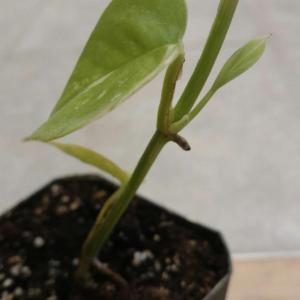




1
0
成长记
Kittiemeu
2017年06月20日

I new added a "Lace Leaf Kalanchoe (Kalanchoe Laciniata)" in my "garden"
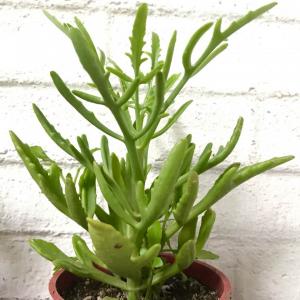

0
0
求助
Lucky Coyote
2017年05月23日

how do I take a rosette or two off of my tiger jaws for propagation without hurting it, and is the leaf in the second picture rotting? it's rather soft compared to the rest of the plant
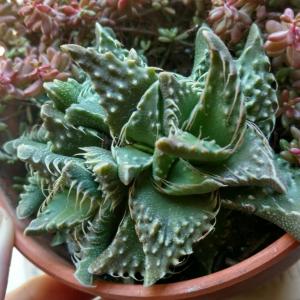
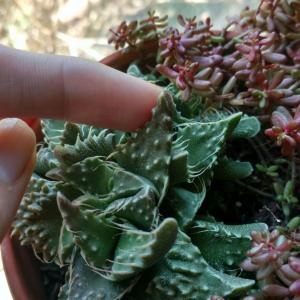


1
0
Ueca:I haven't done it myself, but research tells me that the stem is a crucial part to have on the cutting if you want to propagate it.
文章
安静的美女子
2017年05月23日

Find out how to grow and care for fiddle leaf fig. Learn about the right growing requirements and fiddle leaf fig care below.

Image Credit: Thebrunetteone.com
USDA Zones— 10 – 11, *can be grown indoors in cooler zones
Difficulty— Easy
Scientific Name— Ficus lyrata
Placing a little piece of nature inside the house or apartment does not necessarily mean it will be difficult to maintain. Many plants that offer a beautiful and elegant look in the house are also easy to grow, such as fiddle leaf fig (ficus lyrata). Fiddle Leaf Fig is well suited for growing indoors because it does not become excessively large and at the same time remain noticeable. Fiddle leaf fig care and growing is simple if you fulfill a few basic requirements, which are given below.
Fiddle Leaf Fig Care Information
Fiddle leaf is native to tropics and on its origin place, it grows tall (up to 40 feet), but its size can easily be reduced and kept under control (under 2 m) when grown in pots as a houseplant. Fiddle leaf fig’s leaves are large and dark in color– glossy and leathery, furrowed with yellow veins.
The plant with proper pruning, grows so dense, creating a web of leaves that look elegant and can change the appearance of any room, able to aesthetically fit in any type of environment. It also produces fruit but they are not edible and difficult to develop indoors.
How to Grow Fiddle Leaf Fig TreePropagation
Propagation is usually done from cuttings in the spring. Growing fiddle leaf fig from cuttings is easy, if not available, you can buy a potted plant from nursery and multiply it.
Location
Fiddle leaf fig as a houseplant, grows in a well lit spot. Where it receives indirect sunlight all day long. It likes warm temperature approx. 60 – 70 F (15 – 20 C). When growing fiddle leaf fig, remember that it prefers moist, humid air. Homes are rather dry, so alternatively you can mist the plant often to increase the humidity level.
Requirements for Growing Fiddle Leaf Fig IndoorsSoil
Soil is an essential ingredient in the growth of healthy plant. Loose, well drained soil that is rich in nutrients and organic matter is required.
Watering
Keep the soil slightly moist but let the top 1 inch surface to dry out between watering spells. In the summer it requires frequent watering. In winter, reduce the watering to avoid root rot.
Fiddle Leaf Fig Care

Image Credit: Room for Tuesday
Fiddle leaf fig care is easy, it involves several requirements and steps, which are explained below.
Fertilization
Fertilize about once a month with a water soluble houseplant fertilizer. Avoid fertilizing when it is not in active growth, usually in winter.
Repotting
In every 2-3 years repot the plant or whenever you find that it is root bound, providing a container slightly larger than the previous one.
Cleaning
Cleaning the leaves is an important fiddle leaf plant care step. Its large feathery foliage becomes dusty quite often.
Pruning
Prune your plant to control its size and remove dead and diseased branches, if necessary. Regular pinching of the top of stem once it has reached the desired height prevents the plant from getting lanky and encourages branching.
Pests, Diseases and ProblemsPests
If leaves that have small dark or white diffused patches: this is the sign of the presence of pests, which if not eradicated can damage the plant or lead it to death. The most common pests are mites and cochineal.
It is therefore important to counter them as early as possible as stop the invasion. For evergreens, such as ficus lyrata, attention should always be kept, more in the summer period, when the high temperature and humidity together promote the ideal climate for the development of pests, particularly under the inner leaves, where air circulation is less.
Diseases and Problems
Plant suffers from root rot if grown in waterlogged soil. Ensuring proper drainage and avoiding overwatering prevent this. Whereas, a bad appearance of the foliage or falling leaves are the most obvious symptoms of a few mistakes in the cultivation: Either the plant is exposed to cold drafts or temperature that is too rigid, watering is insufficient or conversely, too abundant. In any case, if treated in time the plant will recover from the damage.

Image Credit: Thebrunetteone.com
USDA Zones— 10 – 11, *can be grown indoors in cooler zones
Difficulty— Easy
Scientific Name— Ficus lyrata
Placing a little piece of nature inside the house or apartment does not necessarily mean it will be difficult to maintain. Many plants that offer a beautiful and elegant look in the house are also easy to grow, such as fiddle leaf fig (ficus lyrata). Fiddle Leaf Fig is well suited for growing indoors because it does not become excessively large and at the same time remain noticeable. Fiddle leaf fig care and growing is simple if you fulfill a few basic requirements, which are given below.
Fiddle Leaf Fig Care Information
Fiddle leaf is native to tropics and on its origin place, it grows tall (up to 40 feet), but its size can easily be reduced and kept under control (under 2 m) when grown in pots as a houseplant. Fiddle leaf fig’s leaves are large and dark in color– glossy and leathery, furrowed with yellow veins.
The plant with proper pruning, grows so dense, creating a web of leaves that look elegant and can change the appearance of any room, able to aesthetically fit in any type of environment. It also produces fruit but they are not edible and difficult to develop indoors.
How to Grow Fiddle Leaf Fig TreePropagation
Propagation is usually done from cuttings in the spring. Growing fiddle leaf fig from cuttings is easy, if not available, you can buy a potted plant from nursery and multiply it.
Location
Fiddle leaf fig as a houseplant, grows in a well lit spot. Where it receives indirect sunlight all day long. It likes warm temperature approx. 60 – 70 F (15 – 20 C). When growing fiddle leaf fig, remember that it prefers moist, humid air. Homes are rather dry, so alternatively you can mist the plant often to increase the humidity level.
Requirements for Growing Fiddle Leaf Fig IndoorsSoil
Soil is an essential ingredient in the growth of healthy plant. Loose, well drained soil that is rich in nutrients and organic matter is required.
Watering
Keep the soil slightly moist but let the top 1 inch surface to dry out between watering spells. In the summer it requires frequent watering. In winter, reduce the watering to avoid root rot.
Fiddle Leaf Fig Care

Image Credit: Room for Tuesday
Fiddle leaf fig care is easy, it involves several requirements and steps, which are explained below.
Fertilization
Fertilize about once a month with a water soluble houseplant fertilizer. Avoid fertilizing when it is not in active growth, usually in winter.
Repotting
In every 2-3 years repot the plant or whenever you find that it is root bound, providing a container slightly larger than the previous one.
Cleaning
Cleaning the leaves is an important fiddle leaf plant care step. Its large feathery foliage becomes dusty quite often.
Pruning
Prune your plant to control its size and remove dead and diseased branches, if necessary. Regular pinching of the top of stem once it has reached the desired height prevents the plant from getting lanky and encourages branching.
Pests, Diseases and ProblemsPests
If leaves that have small dark or white diffused patches: this is the sign of the presence of pests, which if not eradicated can damage the plant or lead it to death. The most common pests are mites and cochineal.
It is therefore important to counter them as early as possible as stop the invasion. For evergreens, such as ficus lyrata, attention should always be kept, more in the summer period, when the high temperature and humidity together promote the ideal climate for the development of pests, particularly under the inner leaves, where air circulation is less.
Diseases and Problems
Plant suffers from root rot if grown in waterlogged soil. Ensuring proper drainage and avoiding overwatering prevent this. Whereas, a bad appearance of the foliage or falling leaves are the most obvious symptoms of a few mistakes in the cultivation: Either the plant is exposed to cold drafts or temperature that is too rigid, watering is insufficient or conversely, too abundant. In any case, if treated in time the plant will recover from the damage.
1
1
lrgarden:good
求助
Lucky Coyote
2017年05月19日

Would anyone happen to know what species of catctus and the strange oval leaf succulent in my terrarium are?
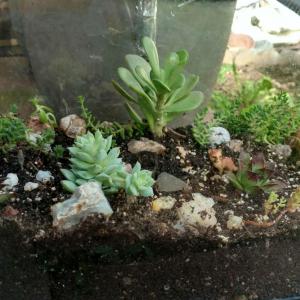
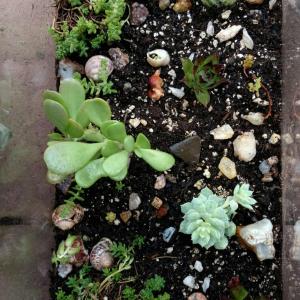




2
0
meriunkat:the oval one is called Senecio Jacobsenii Variegata "Trailing Jade"
Ueca:The rosette plants are Sempervivum, could be tectorum.
Aurora:I think the oval leafed one is a jade



